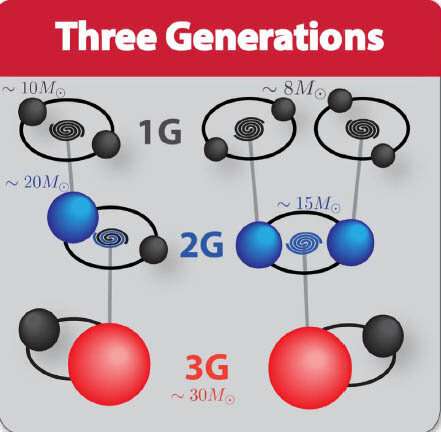Searching for where very unequal mass black hole binaries come from

The direct detection of gravitational waves from at least eleven sources during the past five years has offered spectacular confirmation of Einstein's model of gravity and space-time, while the modeling of these events has provided information on star formation, gamma-ray bursts,neutron stars, the age of the universe, and even verification of ideas about how very heavy elements are produced. The majority of these gravitational wave events arose from the merger of two black holes of comparable masses in an orbiting pair. Near-equal mass pairs are strongly preferred in models of binary black hole formation, whether they result from the evolution of isolated binary stars or from the dynamical pairing of two black holes. This year, however, the LIGO and Virgo gravitational wave observatories reported the first detection of a very unequal mass pair of black holes, GW190412, whose estimated masses are about 30 and eight solar masses. The question, then, is how were they formed?
CfA astronomer Carl Rodriguez led a team of colleagues in a theoretical investigation of how such an unequal mass binary might form. The most obvious solution is look in a dense star cluster, where low-spin, comparable mass black hole pairs can naturally form, in part because massive black holes and stars tend to sink toward the center of the cluster and can more readily encounter each other. But even there those encounters are unlikely to produce an unequal mass pair. The spin of each black hole adds a further complicating factor. The spin is quantified by a number between zero and one. If each of the black holes in a merger has a low value of spin, as is expected, then their merger will normally produce a more massive black hole whose spin is large, perhaps around 0.7, but the inferred spin of the massive black hole in GW190412 is well determined to be about 0.43, suggesting that it did not arise from such a simple merger.
The astronomers argue that the most likely way to produce this unlikely pair may be through two prior black hole pair mergers in the cluster, a process that can ultimately result in a black hole with the correct inferred spin. First, two black hole binary pairs each merge; each of these pairs has black holes of comparable moderate masses and each produces a more massive black hole. Next, these two new black holes themselves form a binary pair and then merge, producing the roughly 30 solar mass, moderate spin black hole as seen. Then that blackhole pairs up with a low mass black hole to form the binary whose collapse produced the event seen as GW190412. (Similar multi-step variants are possible as well.)
Although such a series of events are rare, the scientists show that known star clusters could provide the right environments for it to occur. The new result and analysis, as in the case of previous gravitational wave discoveries, have expanded our view of cosmic variety while tacking fundamental assumptions. One of those assumptions is that black holes are typically formed from stellar collapse with low spins. Future work will show whether a three-step merger process is needed to explain events like GW190412, or whether assumptions like this one about spin need to be challenged instead.
More information: Carl L. Rodriguez et al. GW190412 as a Third-generation Black Hole Merger from a Super Star Cluster, The Astrophysical Journal (2020). DOI: 10.3847/2041-8213/ab961d
Journal information: Astrophysical Journal
Provided by Harvard-Smithsonian Center for Astrophysics





















